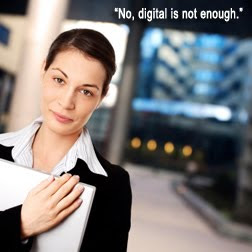 Loyalty programs are everywhere nowadays. Almost every company offers rewards and discounts to join Facebook pages and online communities. Airlines and book stores deliver perks to the people with the most miles on membership cards. Some social media experts even promise to promote their followers for the favor (reciprocal exchanges).
Loyalty programs are everywhere nowadays. Almost every company offers rewards and discounts to join Facebook pages and online communities. Airlines and book stores deliver perks to the people with the most miles on membership cards. Some social media experts even promise to promote their followers for the favor (reciprocal exchanges). But did you ever consider that many loyalty programs aren't really about brand loyalty at all? In many cases, brands are actually undermining customer loyalty with perks and preferred discounts because the incentives they offer reinforce allegiances to discounts over product and service differentials. And in some cases, they disenfranchise brand loyalists all together.
How does it happen? As companies increase the amount of freebies and privileges, the customer becomes more loyal to the "perks" and less attached to the brand. At the same time, some companies undermine the value of customer satisfaction. Ergo, if the only thing keeping a customer returning to a store is a discount, then it's equally likely that they would visit someone else for a slightly better discount.
Worse, hastily planned programs can erode customers on both ends of the spectrum: customers who learn to expect more because of their status within the program (making it an entitlement instead of an incentive) and customers who expect less because they believe any specials are intertwined with sacrifice (quality, service, both).
In some cases, these discrepancies are exceedingly difficult to track. The warning signs occur in the frequency and quality of customer referrals. Either the customers stop referring people or they might refer the perks but not the product or service, per se. Some marketing managers will even hide the problem by suggesting increases in reward programs offered, creating a series of temporary lifts to hide the erosion of loyalty.
So how can you tell the if the loyalty program in place is seen as a positive part of the experience? It's not always easy to really know (short of temporarily withholding perks), but an executive might start by asking what kind of loyalty program they really have.
What is the basis of my loyalty program?
1. Bribery. The most common type of loyalty programs in play today are not loyalty programs at all. They are bribery programs, sometimes with a sense of urgency that demand immediate action. While the program creators will tell you that you have an increase in loyalty, the customers are equally loyal to the price point. (Even when I was working with car companies, customers became savvy enough to wait for seasonal events before visiting dealers. If a customer is willing to wait for a sale, they aren't necessarily loyal.)
2. Addiction. Airlines and hotel chains have been in the business of loyalty programs for some time. The irony is that many of them don't run loyalty programs as much as habits. There was an article in Psychology Todaythat recently pointed this out. The true objective of some of these programs is to make the customer pay more on a habitual basis in order to receive an "incentive" that they could have bought ten times over or chosen another company.
3. Reward. It might not seem so on the surface, but there is a huge chasm between rewards and bribes. And, as long as a company can maintain the distinction, a reward program can enhance customer loyalty. Rewards, especially those that aren't written as part of a purchase point, put the company in the position to exceed customer expectations. The feeling they create is more in line with a thank you and not necessarily a kick back.
Back in January, I read a post that lacked some substance but still managed to nail the concept. Guy Winch, Ph. D., wrote "Customer loyalty occurs because customers’ purchasing behaviors become driven by their feelings for the company, not vice versa." And then he went on to mention that trust (and I might add mutual respect) underpins customer loyalty.
 The general concept is to forge deep personal connections with customers. That way, they will always choose your company regardless of any other factor in the purchasing decision. If they are unwilling to do that, then they aren't loyal whatsoever.
The general concept is to forge deep personal connections with customers. That way, they will always choose your company regardless of any other factor in the purchasing decision. If they are unwilling to do that, then they aren't loyal whatsoever. So how did everything get so out of whack, making loyalty programs so pervasive? There are dozens of reasons, but asking the wrong questions is the most prominent. Specifically, some companies (or perhaps marketing experts) asked the customers if they would be more likely to purchase the product at a lower price or perk. You don't need a survey to tell you the result.
Anytime consumers are given the option of getting something they already buy for less, the answer is yes. The only time they might hesitate is if you weigh the question with consequences. And even then, without the consequences occurring at the time they are asked, consumers will pick the lower price or perk. However, you can also expect a fair amount will complain about those consequences even if it was spelled out to them on the front end.










































